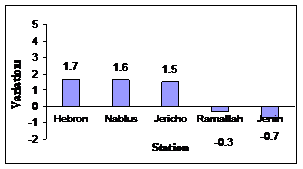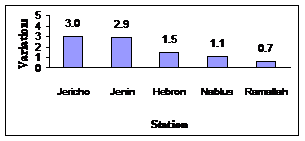Press Release by Palestinian Central Bureau of Statistics (PCBS) and the Palestinian Meteorological Directorate on the Occasion of World Meteorological Day, March 23, 2014
This Year’s Theme: "Weather and Climate: Engaging Youth "
Every year on March 23, the World Meteorological Organization (WMO), which has 189 members, and the global meteorological community celebrate World Meteorological Day around a chosen theme. This year’s theme is “Weather and Climate: Engaging Youth”.
In Palestine, this day is celebrated by meteorological employees, mainly in the Palestinian Meteorological Directorate (PMD).
The PMD conducts optimal observation of climatic conditions in the direct or indirect service of different forms of life to contribute effectively to the development of the national economy. Palestine is an observer in the World Meteorological Organization and a member of the Arab Organization of Meteorology in the League of Arab States.
Meteorological statistics form a crucial part of the environmental statistics collected by PCBS from administrative records.
Weather and Climate: Engaging Youth in Palestine
To engage youth, environmental awareness programs are carried out every year by the Environmental Quality Authority in most schools in Palestine. Activities include seminars, short environmental films and the establishment of environmental clubs to develop environmental awareness and understanding among students. In 2013 35% of schools had an environmental club.
PMD also contributes by welcoming dozens of college students each year in visits to its headquarters in all the governorates.
This press release highlights the most significant meteorological facts relating to Palestine during 2013 (1/1/2013 to 31/12/2013) and the 2013/2014 season up to 16/03/2014 in some West Bank stations as follows:
Higher Average Rainfall in 2013
The amount of rainfall ranged between 806 mm in Nablus station and 148 mm in Jericho during 2013. The yearly average rainfall in Nablus station is 660 mm and 166 mm in Jericho.
Rainfall in 2013, the 2013/2014 season up to 16/03/2014 and yearly average figures in some West Bank stations
|
Station |
Quantity of rainfall (mm) (1/1/2013-31/12/2013) |
% from yearly average |
The 2013/2014 season up to 16/03/2014 |
% from yearly average |
|
Jenin |
480 |
103 |
263 |
56 |
|
Tulkarem |
743 |
123 |
426 |
71 |
|
Nablus |
806 |
122 |
439 |
67 |
|
Ramallah |
771 |
125 |
425 |
69 |
|
Jericho |
148 |
89 |
103 |
62 |
|
Jerusalem |
549 |
88 |
400 |
74 |
|
Bethlehem |
548 |
106 |
346 |
67 |
|
Hebron |
661 |
110 |
447 |
75 |
High Temperatures in 2013 Compared with Yearly Average
Maximum air temperatures during 2013 were higher than the yearly average by 1.7°C in Hebron station; the smallest variation was - 0.7°C in Jenin station.
Variations in maximum air temperature during 2013 (°C) from yearly average in some West Bank stations

Minimum temperatures also differed during 2013 were higher than the yearly average at around 0.7 °C in Ramallah station and 3.0 °C in Jericho station.
Variations in minimum air temperature (°C) compared to yearly average in some West Bank stations, 2013

Highest Annual Humidity in Nablus, Lowest in Jericho
Data showed that annual relative humidity in 2013 ranged between 52% in Jericho station and 72% in Nablus station.
Mean relative humidity (%) in 2013 and yearly average in some West Bank stations
|
Station |
Relative Humidity (%) |
Yearly Average |
% |
|
Jenin |
66 |
69 |
96 |
|
Nablus |
72 |
61 |
118 |
|
Ramallah |
63 |
57 |
111 |
|
Jericho |
52 |
52 |
100 |
|
Hebron |
63 |
62 |
102 |
Higher Average Hours of Sunlight Compared with 2012
During 2013, the average hours of sunlight ranged between 8.9 hours per day in Ramallah station and 8.3 hours per day in Hebron station, compared to 2012 figures of 8.8 hours per day in Ramallah station and 8.2 hours per day in Hebron station.
 عربي
عربي